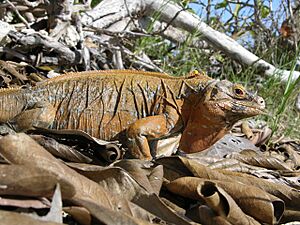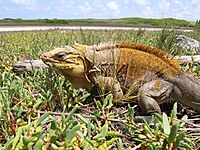Bahamian rock iguana facts for kids
Quick facts for kids Bahamian rock iguana |
|
|---|---|
 |
|
| Conservation status | |
| Scientific classification | |
| Genus: |
Cyclura
|
| Species: |
rileyi
|
| Subspecies | |
|
|
The Bahamian rock iguana (Cyclura rileyi), also known as the San Salvador rock iguana, is a type of lizard that is in danger of disappearing forever. It belongs to the Iguanidae family. These iguanas live only on three island groups in the Bahamas.
Sadly, their numbers are shrinking. This is because people are building on their homes. Also, wild dogs and cats hunt them. There are three different kinds, or subspecies, of this iguana: the Acklins ground iguana, the White Cay iguana, and the San Salvador rock iguana.
Contents
Meet the Bahamian Rock Iguana
The San Salvador rock iguana is a special lizard. It is part of the Cyclura group of iguanas. Leonhard Stejneger first described it in 1903. In the Bahamas, people often just call it "iguana."
How Did It Get Its Name?
The iguana's scientific name, rileyi, comes from an American bird expert named Joseph Harvey Riley. He was the one who first collected a sample of this iguana.
Different Kinds of Bahamian Rock Iguanas
Since 1975, scientists have found two more types of this iguana. These are the Acklins ground iguana (C. r. nuchalis) and the White Cay iguana (C. r. cristata). All three types are among the most threatened rock iguanas in the West Indies. They are listed as critically endangered, meaning they are at very high risk of becoming extinct.
| Image | Scientific Name | Common Name | Where It Lives |
|---|---|---|---|
 |
Cyclura rileyi rileyi | Central Bahamian Rock Iguana, White Cay Ground Iguana | San Salvador, Bahamas |
 |
Cyclura rileyi cristata | White Cay Iguana or Sandy Cay Rock Iguana | White Clay, the Bahamas |
 |
Cyclura rileyi nuchalis | Acklins Ground Iguana | Fish Cay and North Cay in the Acklins Bight, Bahamas |
What Do Bahamian Rock Iguanas Look Like?
Adult San Salvador rock iguanas are about 30 to 39 centimeters (12 to 15 inches) long, not counting their tail. They are very colorful lizards! Their colors can be different depending on the type and even on each iguana.
Colorful Lizards
Their backs can be red, orange, yellow, green, brown, or gray. They usually have darker patterns. The brightest colors, like red, orange, blue, or yellow, are usually seen on males. These colors look even brighter when the iguanas are warm. Young iguanas are not as colorful. They are usually solid brown or gray with faint stripes.
Boys vs. Girls
Like other Cyclura iguanas, male and female Bahamian rock iguanas look a bit different. This is called sexual dimorphism. Males are bigger than females. They also have bigger crests (spiky rows) on their backs. Males have larger pores on their thighs. These pores release special scents called pheromones to communicate.
Where Do Bahamian Rock Iguanas Live?
Long ago, C. rileyi lived on all the big islands of the Bahamas. Today, they only live in six small groups. These groups are found on tiny, faraway islands called cays. These cays are part of three island groups: San Salvador Island, Acklins, and Exuma.
Population Numbers
In 1995, scientists thought there were only about 426 to 639 iguanas left in the wild. This number has probably gone down even more. A big storm called Hurricane Floyd destroyed much of their home in 1999.
Island Homes
The three island groups where these iguanas live are on separate banks. They were not connected even during the last glacial period. This was a time when sea levels were about 100 meters (330 feet) lower than they are now.
What Do Bahamian Rock Iguanas Eat?
Like all Cyclura species, the San Salvador rock iguana mostly eats plants. About 95% of their diet comes from leaves, flowers, and fruits. They eat from at least 7 different plant types. Some of their favorite foods are seaside rock shrub (Rachicallis americana) and erect prickly pear (Opuntia stricta).
Other Food Sources
Sometimes, they might eat other things. This can include insect larvae, crabs, slugs, dead birds, or even fungi. But these are very rare treats.
Mating and Babies
Female San Salvador rock iguanas are ready to have babies when they are about 20 centimeters (8 inches) long from snout to vent. They also need to weigh about 300 grams (11 ounces). Males seem to be ready a little later, around seven years old.
Nesting and Young
Mating usually happens in May and June. The females lay their eggs in June or July. They dig nests in sunny spots in the ground. Each female usually lays 3 to 10 eggs. Young iguanas become very protective of their space when they are about 3 months old.
Protecting the Bahamian Rock Iguana
In the past, native people on the islands sometimes used iguanas as food or in their traditions. But the biggest harm to these animals came when people cleared forests to make farms. Also, new animals that were not from the islands were brought in.
Threats from Other Animals
Animals like black rats, raccoons, wild dogs, mongoose, wild hogs, and cats have hunted many iguanas. A type of moth larvae (Cactoblastis cactorum) also causes problems. These larvae were brought to the Caribbean years ago. They are quickly destroying prickly-pear cacti, which is a very important food source for the iguanas. For example, the iguana group on Guana Cay has fewer than 24 animals left.
Human Dangers
Other dangers from humans include tourists accidentally stepping on iguana nests. The iguanas can also get sick from eating human trash. Some people also try to illegally take and sell them as pets. As more buildings are put up on the islands, iguana groups become more separated. This means they cannot mix and share genes, which is bad for their health.
What's Being Done?
As of August 2007, there are no legal programs to breed these iguanas outside of the Bahamas. The Bahamian government does not allow anyone to take rock iguanas out of the country. However, Ardastra Gardens in Nassau (on New Providence Island, Bahamas) has two young iguanas. They plan to start a breeding program there. There are also plans to teach island residents more about this special lizard. This will help them understand and appreciate it more.



